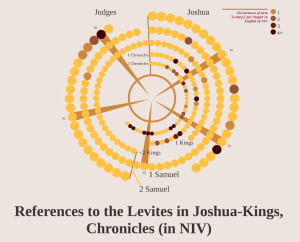It’s funny what occurs to you when you read different books of the Bible simultaneously.
I’ve just finished reading Joshua in the Hebrew, in my grand quest to read the whole OT in Hebrew, and finished Leviticus prior to that. At the same time, a Greek reading group I’m involved with at our college, Melbourne School of Theology, has been working through the Gospel of John.
What I find in such parallel reading experiences is that you see new and exciting connections between the different books.
So, for the record, here are three connections I’d suggest for the book of Joshua:
- Scholars often talk about a ‘Deuteronomistic History’, that is, who would describe Joshua-Judges-Samuel-Kings as an ultimately unified historical work strongly conditioned by the theology that is most systematically articulated in Deuteronomy. This can be construed in a very diachronic way, i.e. almost purely in terms of how these books originated, or in a more synchronic way, seeking the theological and thematic continuities. In my mind both of these angles are interesting and relevant. But I would simply say here that this is an enlightening way to read Joshua. Chapter 1 is clearly designed to correspond to the later chapters of Deuteronomy, esp. ch. 31, or vice versa, with common language about the succession of Joshua for Moses and the importance of discarding fear. Chapter 8 features the covenant-making ceremony recalling the instructions given in Deuteronomy 27. Joshua 22 details at length a controversy about an altar built near the Jordan by the eastern tribes that recalls the instructions about a single altar in Deuteronomy 12 (e.g. see Josh. 22:29). And the historical recollection that prefaces the covenant ceremony of Joshua 24 in its consciousness of having roots ‘across the River’ in Mesopotamia reminds me of the famous confession of Deut. 26:5, “My father was a wandering Aramean.” So I see a clear Deuteronomic influence in Joshua that may be read in terms of a theology and in terms of an editorial stratum, and I don’t think these two angles are mutually exclusive. But that’s not what was new to me!
- Reading Joshua after Leviticus showed me just how ‘priestly’ the book of Joshua is. Priests lead the crossing of the Jordan. Even the infamous ‘ḥērem’ or program of extermination (‘ideal’ though it be) of the Canaanite occupants of the land seems to me to be conducted (or portrayed) in a very priestly and ceremonial manner, along with the punishment of its violation by Achan. On a similar note, but now contrasting with Leviticus, the Levites suddenly make their appearance in Josh. 13:14. Priestly action is unaccompanied by any mention of Levites to this point in Joshua. This is not unlike the Pentateuch: Leviticus does not so much as mention a Levite until ch. 25, and then only in two verses, Lev 25:32-33! It is, ironically, the book of Numbers that teems with references to the Levites. So it is in Joshua: no mention of Levites, but much to priests, in Joshua 1-12; then quite a focus on Levites and their part in the land distribution. While they are denied an inheritance like that of the other tribes, a region to call their own, Joshua 21 offers detailed description of the towns allocated to them to reside in. So I found these priestly/levitical connections interesting, and felt as though all of the historical reportage of Joshua has a kind of priestly, ceremonial frame.
- This might surprise you. I find Joshua akin to the Gospel of John. They might seem quite contrary: John all about how God “loved the world in such a way,” with a love that extends in a sense universally; Joshua making it clearer whom God hates than whom He loves, if that isn’t too pointy a phrasing. But they are Jekyll-and-Hyde alter egos of one another. Both are very theologically geared, more so than their neighbours. Theology constrains the telling of history much more in Joshua than in Judges or Samuel, I feel, and I would say the same about John in comparison with Matthew, Mark and Luke. The result is a much more schematic book in both cases, less shaped by the flow of events and far more by the theological truths needing to be conveyed. The two share a very simple vocabulary too: Joshua a good book for a new reader of biblical Hebrew, and John famously so for a new reader of NT Greek. Yet both offer a profound and quite challenging theology that belies the simplicity of their terminology. Perhaps we could be simplistic ourselves here and give a motto for each book’s message:
- Joshua: “Who ya gonna serve?”
- John: “Who ya gonna trust?”
Time for the real work of the day, but maybe this will challenge your thinking about these three biblical books.





